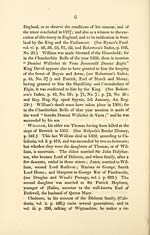Short account of the family of De Vaux, Vaus, or Vans - Latine De Vallibus - of Barnbarroch
(21) Page 5
Download files
Complete book:
Individual page:
Thumbnail gallery: Grid view | List view

5
In 1298 he defended his castle of Dirleton against the fa-
mous Anthony Beck, Bishop cf Durham. In 1304, he was
a principal party to the agreement between Edward of Eng-
land and "John Comyn and his aydents,"" and according to
Ryley's Placeta Par. folio, 369, John Comyn, Edmund
Comyn, John de Graham, and John de Vaux, sealed this
agreement at Strathord, 9th February, 33d of Edward the
First. The sincerity of this submission seems to have been
very doubtful, for in 1306 mention is made of him as a friend
of Robert Bruce's, and an order is given by Edward the First
to Aymer de Valence to seize on the persons of John de Vaus
and Alexander de Seton, and to send them to the King, and
also to seize on the castle of Dirleton, and give it to the keep-
ing of John de Kyngeston. (See Rymer's Faedera, vol. ii.,
p. 1013.) It appears, however, that John made his peace
with Edward, as on the 30th September, 1307, (See Rymer,
vol. iii., p. 14,) an order is given to the Earl of Dunbar,
John de Hastings, John de Fitz-Marmaduke, Robert de
Keth, Alexander de Abernethi, Henry de St. Clair, Alex-
ander de Baliol, and John de Vaus, to proceed against Robert
Bruce in Galloway. (See Ridpath's Border History, p. 233.)
John was sheriff of Edinburgh, and his daughter, Etham, was
married to Sir William de Maulia of Panmure. (See Nis-
bet's Heraldry, vol. ii., part 3, p. 50.) To John succeeded
Thomas, who is mentioned by Guthrie, and Brady, as be-
ing one of the sixty-five Earls, and Lords, who led the Scotch
army at the battle of Halidon Hill, 19th July, 1333.
Thomas was killed in 1346 at the battle of NeviPs Cross,
near Durham, where also his successor
William was taken prisoner. After being detained for
some time in England as a prisoner, (see Rymer's Faed. vol.
v. p. 534, 584, 599,) he returned to Scotland, and his name
appears in many of the transactions of that period, especially
as a party to the ransom of King David the Second, and as
one of the twelve Scots nobles and knights, who obliged them-
selves to compel their king either to return to his captivity in
In 1298 he defended his castle of Dirleton against the fa-
mous Anthony Beck, Bishop cf Durham. In 1304, he was
a principal party to the agreement between Edward of Eng-
land and "John Comyn and his aydents,"" and according to
Ryley's Placeta Par. folio, 369, John Comyn, Edmund
Comyn, John de Graham, and John de Vaux, sealed this
agreement at Strathord, 9th February, 33d of Edward the
First. The sincerity of this submission seems to have been
very doubtful, for in 1306 mention is made of him as a friend
of Robert Bruce's, and an order is given by Edward the First
to Aymer de Valence to seize on the persons of John de Vaus
and Alexander de Seton, and to send them to the King, and
also to seize on the castle of Dirleton, and give it to the keep-
ing of John de Kyngeston. (See Rymer's Faedera, vol. ii.,
p. 1013.) It appears, however, that John made his peace
with Edward, as on the 30th September, 1307, (See Rymer,
vol. iii., p. 14,) an order is given to the Earl of Dunbar,
John de Hastings, John de Fitz-Marmaduke, Robert de
Keth, Alexander de Abernethi, Henry de St. Clair, Alex-
ander de Baliol, and John de Vaus, to proceed against Robert
Bruce in Galloway. (See Ridpath's Border History, p. 233.)
John was sheriff of Edinburgh, and his daughter, Etham, was
married to Sir William de Maulia of Panmure. (See Nis-
bet's Heraldry, vol. ii., part 3, p. 50.) To John succeeded
Thomas, who is mentioned by Guthrie, and Brady, as be-
ing one of the sixty-five Earls, and Lords, who led the Scotch
army at the battle of Halidon Hill, 19th July, 1333.
Thomas was killed in 1346 at the battle of NeviPs Cross,
near Durham, where also his successor
William was taken prisoner. After being detained for
some time in England as a prisoner, (see Rymer's Faed. vol.
v. p. 534, 584, 599,) he returned to Scotland, and his name
appears in many of the transactions of that period, especially
as a party to the ransom of King David the Second, and as
one of the twelve Scots nobles and knights, who obliged them-
selves to compel their king either to return to his captivity in
Set display mode to:
![]() Universal Viewer |
Universal Viewer | ![]() Mirador |
Large image | Transcription
Mirador |
Large image | Transcription
Images and transcriptions on this page, including medium image downloads, may be used under the Creative Commons Attribution 4.0 International Licence unless otherwise stated. ![]()
| Histories of Scottish families > Short account of the family of De Vaux, Vaus, or Vans - Latine De Vallibus - of Barnbarroch > (21) Page 5 |
|---|
| Permanent URL | https://digital.nls.uk/95551681 |
|---|
| Description | A selection of almost 400 printed items relating to the history of Scottish families, mostly dating from the 19th and early 20th centuries. Includes memoirs, genealogies and clan histories, with a few produced by emigrant families. The earliest family history goes back to AD 916. |
|---|

